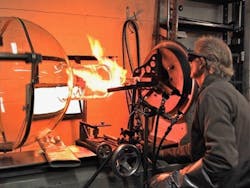Employee Ownership Through the Lens of Two Glass Manufacturers
After three decades in business, New York-based Optimax become the leading precision optics manufacturer in the country, growing an average of 20% year over year, generating $50 million in revenue and including NASA among its top clients. Optimax consistently ranked among the best employers in the Rochester, New York, metro area and proudly employed more than 400 people.
Optimax CEO Rick Plympton and President Mike Mandina sought to guarantee the company’s financial stability and growth while still preserving its employee-focused legacy. They began succession planning with the strong belief that they did not want to sell Optimax to a multinational firm that might take local jobs overseas.
At the same time, across the country in Berkeley, Calif., Tom Adams and George Chittenden were having a similar conversation about a very different manufacturing company. In their case, Adams & Chittenden Scientific Glass had fewer than a dozen employees and filled a very custom niche in the scientific glass-blowing industry.
Having founded one of the only companies in the world that manufactured such specialized laboratory glassware, Adams and Chittenden thought it was highly unlikely that another company would buy them outright. Yet the pair desired a definitive plan for their retirement.
Both of these manufacturers came to the same conclusion: a transition to employee ownership, or “EO.”
Controlling the Pace of Retirement
The pressures of the COVID-19 pandemic have only complicated the retirement calculation for business owners. While manufacturers’ experiences have varied widely during the pandemic, many are experiencing the headaches of unfilled positions, material cost fluctuations and a mangled supply chain.
One benefit of a transition to employee ownership in this climate is that business owners control the pace and can continue to work in the business as long as they like. In both cases, the founders of Adams & Chittenden and Optimax chose to remain in their businesses and gradually transition to retirement.
Over the course of 19 months, Adams & Chittenden transitioned to an employee-ownership. The company had the support of Project Equity, a national nonprofit that helped them line up financing, and the city of Berkeley, where the business is located.
In the two years since transitioning to employee ownership, Chittenden and Adams have stepped back from management of day-to-day operations. Two employee-owners have taken on additional responsibilities, one as administrative lead and the other as shop manager. Adams supports the company with financials part time, and Chittenden focuses his time on what he enjoys most: blowing glass and training the next generation of glass blowers.
Optimax officially transitioned to employee ownership 2020, about five years after Plympton and Mandina first began researching succession planning—so they had plenty of time to plan thoughtfully for the transition. Optimax’s approximately 400 employees benefit today from the company being employee-owned.
Finding the Right EO Model
EO can be a powerful tool to unlock countless opportunities for business owners to sustain their companies, empower their workers and strengthen their communities. EO Equals, a new resource launched for business owners this fall, shows how EO can help increase profits, generate capital for growth, motivate employees and secure owner retirement. Business owners can take an assessment quiz, download a free EO workbook and get connected to one of several nonprofit organizations that can help them find the EO model that would work best for their company:
Employee Stock Ownership Plans (ESOPs), qualified retirement plans that are used to transfer all or part of the company’s shares to a trust, administered on behalf of the employees
Worker-owned cooperatives, traditional management structures with employees holding some board seats and sharing profits based on hours worked
Employee Ownership Trusts (EOTs), a blending of the trust structure with some of the democratic qualities of the worker-owned cooperatives.
The Benefits of EOs
Financial well-being: Owners secure a fair sale price that can support their retirement, or whatever next steps they may have. Transitioning to a broad base of employees can also bring significant tax advantages to the owner, the business and the employees.
Good jobs: Employee-ownership transitions take care of the people who have worked hard to help build the business.
Protected legacy: A strong mission guides many businesses. Whether it is a passion for a niche product or a triple bottom line, who better to carry it on than the people who helped realize the mission?
Positive community impact: Local businesses play a critical role in their communities. Employee ownership keeps them anchored. In addition, it expands the opportunity for people to become business owners and helps employees build equity and further invest in their communities.
Recruiting and retention are the most pressing issues for manufacturers right now. According to the Bureau of Labor Statistics, manufacturing companies had 870,000 open positions in August, nearly double that of a year earlier. Transitioning to employee ownership can engender employee loyalty, preserve good jobs and rebuild local economies. This helps businesses—and communities—thrive for generations to come.
Alison Lingane is co-founder of Project Equity, a San Francisco Bay Area-based nonprofit that raises awareness about employee ownership and provides hands-on consulting to transitioning owners. Project Equity is a founding partner of EO Equals.
